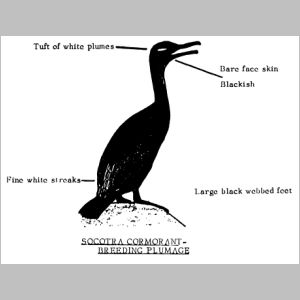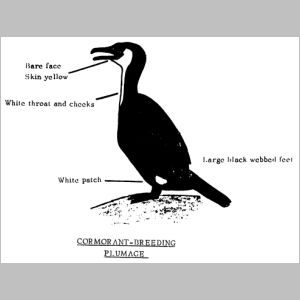Bulletin 13 - March 1981: Cormorants -- Offshore UAE
Cormorants -- Offshore UAE
by Bish BrownIn 1976 John Stewart-Smith (ENHG inaugural Chairman 1976-77) sent an aerial photograph of Zirca Island to an ornithological friend in England. After enlarging certain areas he calculated that the island supported a colony of approximately 150,000 cormorants. There are other reports of flights of "thousands of black birds" continuously passing ships and offshore structures for hours at a time. On 21st January 1981 several hundred cormorants were seen flying westward over the Airport to their evening roosting area.
On 25th October 1977, accompanied by Terry Donohue, I made my only trip to Zirca Island and noted about 5000 cormorants. The breeding season was almost over although there were many variously-sized juveniles on the upper slopes of the hills. Some very young nestlings still had their downy covering. Many birds (up to three different sizes) huddled together in a scraped-out depression on the stony surface. This would indicate that the probable egg-laying period extends from May/June to September. However Meinertzhagen ("Birds of Arabia" 1954) states that the breeding period is from the end of January to mid-March in the northern Gulf.
With the recent rapid build-up of industrial and oil installations on several offshore islands, changes will have occurred in the local distribution of cormorants. Some of the breeding areas will have given way to terminals and camps, so how have the cormorants coped with these changes? Many will probably have moved to other islands, but this is difficult to substantiate. Anyone visiting or living on an offshore island, complex or ship could help us by sending us information on their observations offshore. Details of large flights of birds, breeding areas, dates of egg-laying and hatching and numbers of birds observed, are all required. We would stress, however, that we are very interested in the welfare of the birds and their continued survival in the area, so Irequest as little disturbance as possible.
To help with identification brief descriptions are given of the two species likely to be seen in this area. More detailed descriptions are given in "Handbook of the Birds of Europe, the Middle East and North Africa" Volume I which though very expensive is a good addition to any library.
Socotra Cormorant Pholacrocorax nigrogularisAdult: Entirely black with purple gloss on head and dark green gloss on remainder of upper parts. Bill rather long, grey-black with paler tip and green tinge at base of lower mandible. Bare skin of face blackish, legs black and feet webbed. During breeding season may have tuft of white plumes behind eye and white streaks on rump and neck.
Juvenile: Generally grey-brown above and dirty white below flecked with grey-brown. Bare face dull yellow.
Eggs: Pale blue with chalky covering, dark amber-brown spots and blotches at one end. Average size 57 x 39 mm in clutches of 2 -3.
Cormorant Phalacrocorax carbo
Adult: Larger than Socotra Cormorant. Body velvety-black with purple-blue gloss. Bare parts of head yellowish with white cheeks and throat. During breeding season white patch on both thighs. Bill long, thick and heavy. Legs and webbed feet black.
Juvenile: Crown, nape and body yellow-brown with some darker brown or black. Face, neck and breast dull buff or pale brown. Bare face dull yellow.
Eggs: Pale blue or greenish, covered with chalky white deposit. Average size 66 x 41mm. in clutches of 3 -4.

